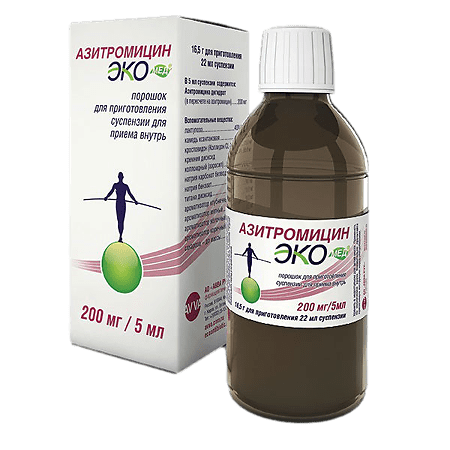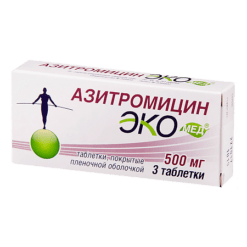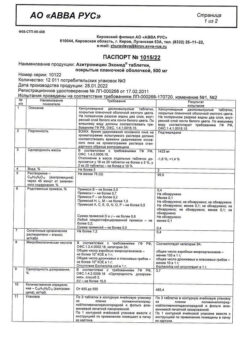No products in the cart.
Azithromycin Ecomed, 200 mg/5 ml 16.5g
€1.00
Out of stock
(E-mail when Stock is available)
Description
A broad spectrum antibacterial agent of the group of macrolides-azalides has a bacteriostatic effect.
Binding to 50S subunit of ribosomes, it inhibits peptide translocase at the translation stage, inhibits protein synthesis, inhibits bacterial growth and reproduction, in high concentrations it has bactericidal effect.
It acts on extra- and intracellularly located pathogens.
Microorganisms may be initially resistant to the antibiotic or may become resistant to it.
Azithromycin sensitivity scale for microorganisms (Minimum inhibitory concentration, mg/L):
Microorganisms Sensitive Resistant<./strong>
Staphylococcus ≤ 1 > 2
Streptococcus A, B, C, G ≤ 0.25 > 0.5
Streptococcus pneumoniae ≤ 0.25 > 0.5
Haemophilus influenzae ≤ 0.12 > 4
Moraxella catarrhalis ≤ 0.5 > 0.5
Neisseria gonorrhoeae ≤ 0.25 > 0.5
Sensitive:
aerobic gram-positive microorganisms:
Staphylococcus aureus (methicillin-sensitive),
Streptococcus pneumoniae (penicillin-sensitive),
Streptococcus pyogenes;
aerobic gram-negative microorganisms:
Haemophilus influenzae,
Haemophilus parainfluenzae,
Legionella pneumophila,
Moraxella catarrhalis,
Pasteurella multocida,
Neisseria gonorrhoeae;
anaerobic microorganisms:
Clostridium perfringens,
Fusobacterium spp,
Prevotella spp,
Porphyromonas spp.
Other:
Chlamydia trachomatis,
Chlamydia pneumoniae,
Chlamydia psittaci,
Mycoplasma pneumoniae,
Mycoplasma hominis,
Borrelia burgdorferi.
Moderately sensitive or insensitive:
aerobic gram-positive microorganisms:
Streptococcus pneumoniae (moderately sensitive or resistant to penicillin).
Resistant:
aerobic gram-positive microorganisms:
Enterococcus faecalis,
Methicillin-resistant strains of Staphylococcus aureus.
Anaerobes:
Bacteroides fragilis group.
Streptococcus pneumoniae, beta-haemolytic Streptococcus spp. group A, Enterococcus faecalis and Staphylococcus aureus (including methicillin-sensitive strains), resistant to erythromycin and other macrolides, Lincosamides, also resistant to azithromycin.
Pharmacokinetics
After oral administration azithromycin is well absorbed and rapidly distributed in the body. Bioavailability after a single use of 0.5 g is 37% (effect of “first passage” through the liver), maximum concentration (Cmax) after oral use of 0.5 g is 0.4 mg/l, time to reach maximum concentration (TCmax) is 2-3 hours. Concentration in tissues and cells is 10-50 times higher than in serum. The volume of distribution is 31.1 l/kg, the binding with plasma proteins is inversely proportional to the concentration in blood and is 7-50%.
Azithromycin is acid-resistant and lipophilic. It easily passes through histohematic barriers, penetrates well into the respiratory tract, internal organs and tissues, including the prostate, skin and soft tissues. It is also transported to the site of infection by phagocytes, polymorphonuclear leukocytes and macrophages, where it is released in the presence of bacteria. It penetrates through cell membranes and creates high concentrations in cells, which is especially important for eradication of intracellularly located pathogens.
In the foci of infection the concentration is 24-34% higher than in healthy tissues and correlates with the severity of the inflammatory process. It remains in effective concentrations for 5-7 days after the last dose.
It is demethylated in liver, formed metabolites are not active. CYP3A4, CYP3A5, CYP3A7 isoenzymes are involved in metabolism of the drug. Plasma clearance is 630 ml/min: elimination half-life between 8 and 24 hours after drug intake is 14-20 hours; the elimination half-life between 24 and 72 hours is 41 hours. More than 50% of the drug is excreted unchanged in intestine, 6% – by kidneys.
Meal consumption significantly changes pharmacokinetics: Cmax increases (by 31 %), area under curve “concentration-time” (AUC) does not change.
Pharmacokinetic parameters do not change in elderly men (65-85 years old), in women Cmax increases (by 30-50 %).
Indications
Indications
Infectious and inflammatory diseases caused by microorganisms sensitive to azithromycin:
• infections of the upper respiratory tract and ENT organs: pharyngitis, tonsillitis, sinusitis, otitis media;
• lower respiratory tract infections: acute bronchitis, exacerbation of chronic bronchitis, pneumonia, incl. caused by atypical pathogens;
• skin and soft tissue infections: erysipelas, impetigo, secondary infected dermatoses;
• the initial stage of Lyme disease (borreliosis) – erythema migrans.
Pharmacological effect
Pharmacological effect
A broad-spectrum antibacterial drug from the group of macrolides-azalides, has a bacteriostatic effect.
By binding to the 50S ribosomal subunit, it inhibits peptide translocase at the translation stage, suppresses protein synthesis, slows down the growth and reproduction of bacteria, and in high concentrations has a bactericidal effect.
Acts on extra- and intracellularly located pathogens.
Microorganisms may be initially resistant to the action of an antibiotic or may acquire resistance to it.
Scale of sensitivity of microorganisms to azithromycin (Minimum inhibitory concentration, mg/l):
Microorganisms SensResistant
Staphylococcus ≤ 1 > 2
Streptococcus A, B, C, G ≤ 0.25 > 0.5
Streptococcus pneumoniae ≤ 0.25 > 0.5
Haemophilus influenzae ≤ 0.12 > 4
Moraxella catarrhalis ≤ 0.5 > 0.5
Neisseria gonorrhoeae ≤ 0.25 > 0.5
Sensitive:
aerobic gram-positive microorganisms:
Staphylococcus aureus (methicillin-sensitive),
Streptococcus pneumoniae (penicillin-sensitive),
Streptococcus pyogenes;
aerobic gram-negative microorganisms:
Haemophilus influenzae,
Haemophilus parainfluenzae,
Legionella pneumophila,
Moraxella catarrhalis,
Pasteurella multocida,
Neisseria gonorrhoeae;
anaerobic microorganisms:
Clostridium perfringens,
Fusobacterium spp.,
Prevotella spp.,
Porphyromonas spp.;
others:
Chlamydia trachomatis,
Chlamydia pneumoniae,
Chlamydia psittaci,
Mycoplasma pneumoniae,
Mycoplasma hominis,
Borrelia burgdorferi.
Moderately sensitive or insensitive:
aerobic gram-positive microorganisms:
Streptococcus pneumoniae (moderately sensitive or resistant to penicillin).
Resistant:
aerobic gram-positive microorganisms:
Enterococcus faecalis,
Methicillin-resistant strains of Staphylococcus aureus.
Anaerobes:
Bacteroides fragilis group.
Streptococcus pneumoniae, beta-hemolytic Streptococcus spp. group A, Enterococcus faecalis and Staphylococcus aureus (including methicillin-sensitive strains), resistant to erythromycin and other macrolides, lincosamides, and resistant to azithromycin.
Pharmacokinetics
After oral administration, azithromycin is well absorbed and quickly distributed in the body. Bioavailability after a single dose of 0.5 g is 37% (the “first pass” effect through the liver), maximum concentration (Cmax) after oral administration of 0.5 g is 0.4 mg/l, time to reach maximum concentration (TCmax) is 2-3 hours. Concentration in tissues and cells is 10-50 times higher than in serum. The volume of distribution is 31.1 l/kg, binding to plasma proteins is inversely proportional to the concentration in the blood and amounts to 7-50%.
Azithromycin is acid-stable and lipophilic. Easily passes through histohematic barriers, penetrates well into the respiratory tract, internal organs and tissues, including the prostate gland, skin and soft tissues. It is also transported to the site of infection by phagocytes, polymorphonuclear leukocytes and macrophages, where it is released in the presence of bacteria. Penetrates through cell membranes and creates high concentrations in them, which is especially important for the eradication of intracellular pathogens.
In foci of infection, the concentration is 24-34% higher than in healthy tissues and correlates with the severity of the inflammatory process. Remains in effective concentrations for 5-7 days after taking the last dose.
It is demethylated in the liver, the resulting metabolites are not active. The metabolism of the drug involves isoenzymes CYP3A4, CYP3A5, CYP3A7, of which it is an inhibitor. Plasma clearance – 630 ml/min: half-life between 8 and 24 hours after administration – 14-20 hours, half-life in the range from 24 to 72 hours – 41 hours. More than 50% of the drug is excreted unchanged through the intestines, 6% by the kidneys.
Food intake significantly changes pharmacokinetics: Cmax increases (by 31%), the area under the concentration-time curve (AUC) does not change.
In elderly men (65-85 years old), the pharmacokinetic parameters do not change; in women, Cmax increases (by 30-50%).
Special instructions
Special instructions
If you miss one dose of azithromycin, the missed dose should be taken as soon as possible, and subsequent doses should be taken at intervals of 24 hours.
Azithromycin should be taken at least one hour before or two hours after taking antacid medications.
Azithromycin should be used with caution in patients with mild to moderate hepatic impairment due to the possibility of developing fulminant hepatitis and severe hepatic failure.
If there are symptoms of liver dysfunction, such as rapidly increasing asthenia, jaundice, dark urine, bleeding tendency, hepatic encephalopathy, azithromycin therapy should be discontinued and a study of the functional state of the liver should be performed.
In case of impaired renal function: in patients with GFR (glomerular filtration rate) 10-80 ml/min, no dose adjustment is required; azithromycin therapy should be carried out with caution under monitoring the state of renal function
As with the use of other antibacterial drugs, during therapy with azithromycin, patients should be regularly examined for the presence of non-susceptible microorganisms and signs of the development of superinfections, including fungal ones.
Azithromycin should not be used in longer courses than indicated in the instructions, since the pharmacokinetic properties of azithromycin allow us to recommend a short and simple dosage regimen.
There is no data on a possible interaction between azithromycin and ergotamine and dihydroergotamine derivatives, but due to the development of ergotism with the simultaneous use of macrolides with ergotamine and dihydroergotamine derivatives, this combination is contraindicated
With long-term use of azithromycin, the development of pseudomembranous colitis caused by Clostridium difficile, both in the form of mild diarrhea and severe colitis, is possible. If antibiotic-associated diarrhea develops while taking azithromycin, as well as 2 months after the end of therapy, clostridial pseudomembranous colitis should be excluded. Do not use drugs that inhibit intestinal motility.
When treated with macrolides, including azithromycin, prolongation of cardiac repolarization and QT interval was observed, increasing the risk of developing cardiac arrhythmias, including torsade de pointes, which can lead to cardiac arrest.
Caution should be exercised when using azithromycin in patients with the presence of proarrhythmogenic factors (especially in elderly patients), including congenital or acquired prolongation of the QT interval, in patients taking antiarrhythmic drugs of classes IA (quinidine, procainamide), III (dofetilide, amiodarone and sotalol), cisapride, terfenadine, antipsychotic drugs (pimozide), antidepressants (citalopram), fluoroquinolones (moxifloxacin and levofloxacin), with disturbances in water and electrolyte balance, especially in the case of hypokalemia or hypomagnesemia, with clinically significant bradycardia, cardiac arrhythmia or severe heart failure.
The use of azithromycin may provoke the development of myasthenic syndrome or cause an exacerbation of myasthenia gravis.
Impact on the ability to drive vehicles and machinery
During the treatment period, care must be taken when driving vehicles and engaging in other potentially hazardous activities that require increased concentration and speed of psychomotor reactions.
Active ingredient
Active ingredient
Azithromycin
Composition
Composition
Composition of components in 5 ml suspension:
Active ingredient:
azithromycin dihydrate 104.82 mg 209.64 mg
(in terms of azithromycin) 100.00 mg 200.00 mg
Excipients:
lactitol 200.00 mg 400.00 mg
sodium carbonate anhydrous 83.00 mg 83.00 mg
crospovidone (kollidon CL-M) 65.00 mg 65.00 mg
strawberry flavor 55.00 mg 55.00 mg
sodium benzoate 16.50 mg 16.50 mg
xanthan gum 15.00 mg 15.00 mg
apple flavor 13.75 mg 13.75 mg
cinnamon flavor 13.75 mg 13.75 mg
titanium dioxide 10.00 mg 10.00 mg
colloidal silicon dioxide 5.50 mg 5.50 mg
mint flavor 0.50 mg 0.50 mg
sucrose to weight 3.75 g 3.75 g
Pregnancy
Pregnancy
Pregnancy
During pregnancy, azithromycin is used only if the expected benefit to the mother outweighs the potential risk to the fetus.
Breastfeeding period
During breastfeeding, it is used only if the expected benefit to the mother outweighs the potential risk to the child. If it is necessary to use azithromycin during breastfeeding, it is recommended to stop breastfeeding.
Contraindications
Contraindications
hypersensitivity to azithromycin (including other macrolides) or other components of the drug;
severe renal failure (creatinine clearance (CC) less than 40 ml/min);
severe liver failure (class C on the Child-Pugh scale);
breast-feeding;
simultaneous use with ergotamine and dihydroergotamine;
children up to 6 months;
sucrase/isomaltase deficiency, fructose intolerance, glucose-galactose malabsorption;
hypersensitivity to erythromycin; ketolides.
With caution
Pregnancy, myasthenia gravis, mild to moderate liver dysfunction, mild to moderate renal dysfunction (creatinine clearance more than 40 ml/min), diabetes mellitus, in patients with proarrhythmogenic factors (especially elderly patients): with congenital or acquired prolongation of the QT interval, in patients receiving therapy with antiarrhythmic drugs of classes IA (quinidine, procainamide), III (dofetilide, amiodarone and sotalol), cisapride, terfenadine, antipsychotics (pimozide), antidepressants (citalopram), fluoroquinolones (moxifloxacin and levofloxacin), with fluid and electrolyte imbalance, especially in the case of hypokalemia or hypomagnesemia, with clinically significant bradycardia, cardiac arrhythmia or severe heart failure; simultaneous use of digoxin, warfarin, cyclosporine.
Side Effects
Side Effects
Infectious and parasitic diseases
uncommon: candidiasis, including oral mucosa, vaginal infection, pneumonia, fungal infection, bacterial infection, pharyngitis, gastroenteritis, respiratory diseases, rhinitis
unknown frequency: pseudomembranous colitis
Blood and lymphatic system disorders
uncommon: leukopenia, neutropenia, eosinophilia
very rare: thrombocytopenia, hemolytic anemia
Metabolic and nutritional disorders
uncommon: anorexia
Immune system disorders
uncommon: angioedema, hypersensitivity reaction
unknown frequency: anaphylactic reaction
Nervous system disorders
often: headache
uncommon: dizziness, disturbance of taste, paresthesia, drowsiness, insomnia, nervousness
rarely: agitation
unknown frequency: hypoesthesia, anxiety, aggression, syncope, convulsions, psychomotor hyperactivity, loss of smell, perverted sense of smell, loss of taste, myasthenia gravis, delusions, hallucinations
Visual disorders
often: visual impairment
Hearing and labyrinth disorders
uncommon: hearing loss, vertigo
unknown frequency: hearing impairment, including deafness and/or tinnitus
Cardiovascular system disorders
uncommon: palpitations
very rare: arrhythmia
unknown frequency: increased QT interval on the electrocardiogram, torsade de pointes arrhythmia, ventricular tachycardia
Vascular disorders
infrequently: “flushes” of blood to the face
unknown frequency: decreased blood pressure
Disorders of the respiratory system, chest and mediastinal organs
uncommon: shortness of breath, nosebleeds
Gastrointestinal disorders
very common: diarrhea
often: nausea, vomiting, abdominal pain
uncommon: flatulence, dyspepsia, constipation, gastritis, dysphagia, bloating, dry oral mucosa, belching, ulcers of the oral mucosa, increased secretion of the salivary glands
very rare: discoloration of the tongue, pancreatitis
Disorders of the liver and biliary tract
uncommon: hepatitis
rare: liver dysfunction, cholestatic jaundice
unknown frequency: liver failure (in rare cases, fatal, mainly due to severe liver dysfunction); liver necrosis, fulminant hepatitis
Disorders of the skin and subcutaneous tissues
uncommon: skin rash, itching, urticaria, dermatitis, dry skin, sweating
rare: photosensitivity reaction
unknown frequency: Stevens-Johnson syndrome, toxic epidermal necrolysis, erythema multiforme, drug rash with eosinophilia and systemic manifestations (DRESS syndrome)
Musculoskeletal and connective tissue disorders
uncommon: osteoarthritis, myalgia, back pain, neck pain
unknown frequency: arthralgia
Renal and urinary tract disorders
uncommon: dysuria, pain in the kidney area
unknown frequency: interstitial nephritis, acute renal failure
Disorders of the genital organs and breast
uncommon: metrorrhagia, testicular dysfunction
General disorders and disorders at the injection site
uncommon: edema, asthenia, malaise, feeling tired, facial swelling, chest pain, fever, peripheral edema
Influence on the results of laboratory and instrumental studies
often: decreased number of lymphocytes, increased number of eosinophils, increased number of basophils, increased number of monocytes, increased number of neutrophils, decreased concentration of bicarbonates in blood plasma
infrequently: increased activity of aspartate aminotransferase, alanine aminotransferase, increased concentration of bilirubin in the blood plasma, increased concentration of urea in the blood plasma, increased concentration of creatinine in the blood plasma, change in the potassium content in the blood plasma, increased activity of alkaline phosphatase in the blood plasma, increased chloride content in the blood plasma, increased concentration of glucose in the blood, increased platelet count, decreased hematocrit, increased concentration of bicarbonates in plasma blood, changes in sodium content in blood plasma
Interaction
Interaction
Antacids (aluminum and magnesium containing) do not affect bioavailability, but reduce the concentration of azithromycin in the blood by 30%, so the interval between their administration should be 1 hour before or 2 hours after taking these drugs.
When used simultaneously with ergotamine and dihydroergotamine derivatives, the toxic effect of the latter may be enhanced (vasospasm, dysesthesia).
When used together with indirect coumarin anticoagulants (warfarin), patients need careful monitoring of prothrombin time.
Caution must be exercised when co-administering terfenadine and azithromycin, since concomitant use of terfenadine and macrolides has been found to cause arrhythmia and prolongation of the QT interval. Based on this, the above complications cannot be excluded when taking terfenadine and azithromycin together.
When used simultaneously with cyclosporine, it is necessary to monitor the concentration of cyclosporine in the blood. When azithromycin and cyclosporine are used simultaneously, a dose adjustment of cyclosporine is necessary.
When used simultaneously with digoxin, it is necessary to control the concentration of digoxin in the blood (it is possible to increase the absorption of digoxin in the intestine). The simultaneous use of azithromycin (1200 mg) and nelfinavir (750 mg 3 times a day) causes an increase in the equilibrium concentration of azithromycin in the blood plasma; no clinically significant side effects were observed and dose adjustments of azithromycin were used simultaneously with nelfinavir is not required.
When used concomitantly with zidovudine, azithromycin has little effect on the pharmacokinetics, including renal excretion, of zidovudine or its glucuronide metabolite. Azithromycin weakly interacts with cytochrome P450 isoenzymes; it has not been revealed that azithromycin is involved in pharmacokinetic interactions similar to erythromycin and other macrolides; azithromycin is not an inducer or inhibitor of the cytochrome P450 isoenzyme.
Neutropenia has occasionally been observed with concomitant use of azithromycin and rifabutin, although neutropenia has been associated with the use of rifabutin; a causal relationship between the use of the combination of azithromycin and rifabutin and neutropenia has not been established.
Azithromycin does not affect the blood concentrations of carbamazepine, cimetidine, didanosine, efavirenz, fluconazole, indinavir, midazolam, theophylline, triazolam, trimethoprim/sulfamethoxazole, cetirizine, sildenafil, atorvastatin, rifabutin and methylprednisolone when used simultaneously.
There have been isolated case reports of rhabdomyolysis in patients taking azithromycin and statins concomitantly.
Overdose
Overdose
Symptoms: temporary hearing loss, nausea, vomiting, diarrhea.
Treatment: symptomatic.
Storage conditions
Storage conditions
In a place protected from moisture and light at a temperature not exceeding 25 ° C.
The prepared suspension is stored at a temperature from 2 ºС to 8 ºС in a tightly closed bottle.
Keep out of the reach of children.
Shelf life
Shelf life
2 years.
Ready suspension – 5 days.
Do not use after expiration date.
Manufacturer
Manufacturer
ABVA RUS, Russia
Additional information
| Shelf life | 2 years. Ready suspension – 5 days. Do not use after the expiration date. |
|---|---|
| Conditions of storage | Store in a place protected from moisture and light at a temperature not exceeding 25 °С. Ready suspension is stored at 2 to 8°C in a tightly closed bottle. Keep out of reach of children. |
| Manufacturer | Avva Rus, Russia |
| Medication form | Powder for oral suspension |
| Brand | Avva Rus |
Other forms…
Related products
Buy Azithromycin Ecomed, 200 mg/5 ml 16.5g with delivery to USA, UK, Europe and over 120 other countries.

















